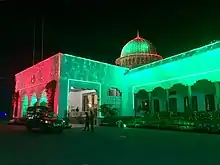Shah Jalal Dakhini
Shah Jalal Dakhini (Bengali: শাহ জালাল দাখিনী, Arabic: شاه جلال داخني) was a 15th-century Sufi Muslim figure of Dhaka, eastern Bengal (now Bangladesh).[1] Dakhini was one among the many Sufis who spread Islam in eastern India.[2] Saint received an honorifics as a Dakhini as he was the resident of Deccan.[1][3]
Jalal Dakhini | |
|---|---|
| Other names | Sha Jolal Deccani |
| Personal | |
| Born | |
| Died | 1476 CE |
| Resting place | Bangabhaban, Dilkusha, Motijheel Thana, Dhaka, Bangladesh |
| Religion | Islam |
| Denomination | Sunni |
| Other names | Sha Jolal Deccani |
| Muslim leader | |
| Period in office | 15th century |
Biography
It is debated whether Dakhini was originally from the Deccan Plateau in South India (as his name suggests) or that he was from Gujarat in Western India. According to 'Abd al-Haqq al-Dehlawi's Akhbar-ul-Akhyar, Dakhini studied under Shaykh Piyara in North India. Piyara was a Bengali Muslim scholar of the Chishti Order.[4][5]
One day, he set off with a few companions from Gujarat to eastern Bengal, during the reign of the Sultan of Bengal Shamsuddin Yusuf Shah. He established a khanqah in present-day Motijheel, Dhaka in order to propagate Islamic teachings to the local people.[1] He gained a large following in Dhaka, so much so that it was seemingly proportionate to the power of a king. It is said he also started to have a very pompous attitude.[4] According to legend, the Sultan was angered by this, viewing Dakhini as a threat, and so had Dakhini and his comrades executed in 1476. Dakhini and one of his disciples were both buried in a single-domed mazar (mausoleum) in two separate tombs. This is now found northeast of the Bangabhaban gateway.[6][7]
Legacy

The tomb has been renovated over the years by its zamindars namely Khwaja Ahsanullah and RAJUK.[8][9][10][11] During the Mughal period, a mosque was built named after Dakhini. This mosque has now been renovated and renamed by RAJUK as the Dilkusha Jame Masjid.
References
- Bhuiyan, Mosharraf Hussain (2012). "Shah Jalal Dakhini (R)". In Islam, Sirajul; Miah, Sajahan; Khanam, Mahfuza; Ahmed, Sabbir (eds.). Banglapedia: the National Encyclopedia of Bangladesh (Online ed.). Dhaka, Bangladesh: Banglapedia Trust, Asiatic Society of Bangladesh. ISBN 984-32-0576-6. OCLC 52727562. Retrieved 3 February 2021.
- SAIDUL.), MD NAZRUL ISLAM ISLAM (MD; Islam, Nazrul (20 March 2020). Islam and Democracy in South Asia: The Case of Bangladesh. Springer Nature. ISBN 978-3-030-42909-6.
- Ahmed, Rafiuddin (1996). The Bengal Muslims, 1871-1906: A Quest for Identity. Oxford University Press. ISBN 978-0-19-563919-3.
- Abdul Mannan Talib (1980). Bangladeshe Islam. Adhunika Prakasani.
- 'Abd al-Haqq al-Dehlawi (1500s). Akhbar-ul-Akhyar.
- Hundred Years of Bangabhaban, 1905-2005. Press Wing Bangabhaban. 2006. ISBN 978-984-32-1583-3.
- "Revisiting Dhaka's Treasures". The Daily Star. 2016-03-05. Retrieved 2020-06-23.
- "Motijheel Commercial Area . Dhaka". bdnewsnet.com. 2018-10-02. Retrieved 2020-06-23.
- Population Census of Bangladesh, 1974: District census report. Bangladesh Bureau of Statistics, Statistics Division, Ministry of Planning, Government of the People's Republic of Bangladesh. 1979.
- "Discover and Expore Bangladesh | By Bangladesh.com | Presidential Palace of Bangabhaban". Discover and Expore Bangladesh | By Bangladesh.com. Retrieved 2020-06-23.
- Dani, Ahmad Hasan (1962). Dacca: A Record of Its Changing Fortunes. Mrs. S. S. Dani.
